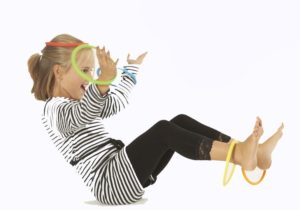Hand-eye coordination: In hand-eye coordination the eyes and the hands work together in order to perform an activity or reach a goal.
A child cannot learn to eat properly, if he or she has poor hand-eye coordination skills. To eat, the child must see the food, reach out and then bring the food up to his/her mouth. In other words, hand-eye coordination is one of the first functions to give children a sense of mastery – doing something for themselves and thereby developing a sense of independence.
Three senses are activated when training hand-eye coordination. In addition to sight (eyes) and touch (hands), the child‘s proprioceptive sense is involved in moving his/her hands, arms and sometimes the body too.
The proprioceptive sense is activated to regulate the force and movement required to stabilise the body and hold it steady. Accurate manipulation of small objects and precise eating and writing depend on our ability to stabilise arm and torso. Hand-eye coordination develops from infancy and is refined throughout childhood.
In childhood, the function develops through play, in which the child manipulates his/her toys and explores them with hands and mouth. This function is later refined. The child learns to catch an object when it is thrown or can throw in a specific direction.
Hand-eye coordination is essential as it allows the child to use cutlery when eating, and to draw figuratively and write legibly so that drawing and writing become useful as means of communication.
When a child has difficulty coordinating his/her hands and eyes, he/she faces challenges associated with one or more of the three senses mentioned above. The child has to be tested and examined with great care.




Leave A Comment